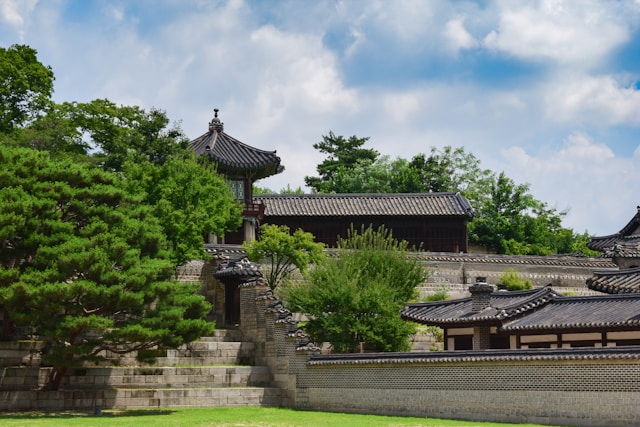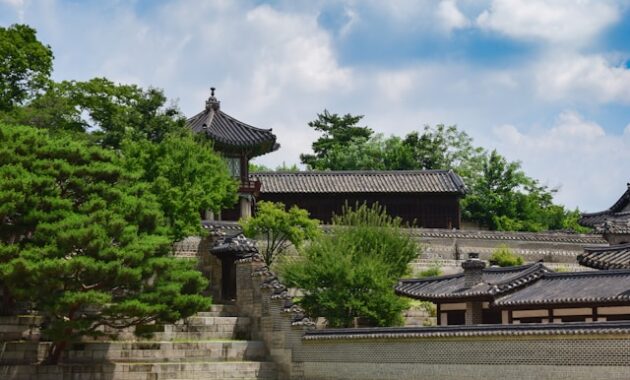
Seoul, the vibrant capital of South Korea, is a city where the past and present coexist harmoniously. Its streets are lined with historical landmarks that tell the story of a city steeped in tradition, resilience, and cultural pride. From ancient palaces to modern commemorative sites, let us guide you through the most fascinating historical landmarks in Seoul that will leave you awe-inspired.
1. Gyeongbokgung Palace: The Grand Jewel of the Joseon Dynasty
No exploration of Seoul’s history is complete without a visit to Gyeongbokgung Palace, the largest and most iconic of the five grand palaces built during the Joseon Dynasty. Constructed in 1395, this majestic site embodies the zenith of Korean architectural design.
Visitors can marvel at the Geunjeongjeon Hall, the main throne hall where kings held court, and the serene beauty of Hyangwonjeong Pavilion, a picturesque structure set amidst a tranquil pond. Don’t miss the changing of the royal guard ceremony, which adds a touch of historical authenticity to your experience.
2. Changdeokgung Palace and Huwon: A UNESCO World Heritage Gem

Known for its seamless integration with the natural landscape, Changdeokgung Palace is a UNESCO World Heritage Site that exudes harmony and elegance. The secret garden, or Huwon, is a verdant oasis where royalty once sought solace from the pressures of governance.
The palace’s unique blend of Confucian ideals and environmental design makes it a must-see for history enthusiasts and architecture lovers alike.
3. Bukchon Hanok Village: A Journey into Traditional Korean Life
Nestled between Gyeongbokgung and Changdeokgung Palaces lies Bukchon Hanok Village, a living museum of Seoul’s traditional hanok houses. These beautifully preserved homes date back to the Joseon era and offer a glimpse into Korea’s architectural heritage.
Visitors can wander the cobblestone streets, explore cultural workshops, and even experience a stay in a hanok guesthouse. This charming village is a perfect blend of history and modernity, making it a favorite for photographers and history buffs alike.
4. Jongmyo Shrine: Honoring Royal Ancestors
The Jongmyo Shrine, another UNESCO World Heritage Site, stands as the oldest and most authentic Confucian royal shrine in the world. Built in the late 14th century, this sacred site is dedicated to the ancestors of the Joseon kings.
Every year, the shrine hosts the Jongmyo Jerye, an elaborate Confucian ritual that has been designated as an Intangible Cultural Heritage by UNESCO. The tranquil surroundings and deep spiritual significance of this site make it a poignant stop on any historical tour of Seoul.
5. Namhansanseong Fortress: A Symbol of Resilience
Located on the outskirts of Seoul, Namhansanseong Fortress was strategically built to protect the Joseon capital from invasions. This historic mountain fortress, which dates back to the 7th century, offers sweeping views of the city and surrounding landscapes.
Exploring the fortress, visitors can learn about its critical role in Korean history and its use as a temporary refuge for the king during times of war.
6. Seodaemun Prison History Hall: A Sobering Reminder of Colonial Struggles
The Seodaemun Prison History Hall provides a stark and sobering look into Korea’s struggle for independence during the Japanese occupation. Built in 1908, this former prison has been transformed into a museum that chronicles the hardships faced by Korean patriots.
Exhibits include authentic prison cells, execution chambers, and artifacts that tell the stories of those who fought for the nation’s freedom. This site is a powerful reminder of Korea’s resilience and determination.
7. Deoksugung Palace and Its Stone-Walled Path
Famous for its beautiful stone-walled pathway, Deoksugung Palace offers a unique blend of traditional Korean and Western-style architecture. The palace served as a royal residence during the late Joseon period and features notable structures like the Seokjojeon Hall, a Western-style building used for diplomatic affairs.
The illuminated night views of Deoksugung and its cultural performances make it a romantic and memorable destination.
8. Dongdaemun Design Plaza: Where History Meets Modernity
While primarily known for its futuristic design, the Dongdaemun Design Plaza (DDP) is also a site of historical significance. Built atop the grounds of the former Seonggwak City Wall, the plaza incorporates preserved sections of the wall into its design, creating a striking contrast between the old and the new.
The DDP hosts exhibitions and cultural events, making it a hub for creativity while honoring Seoul’s historical roots.
9. Namsangol Hanok Village: A Slice of the Joseon Era
Tucked away in the bustling cityscape is Namsangol Hanok Village, a collection of restored hanok houses that transport visitors to the heart of the Joseon Dynasty. This open-air museum provides an immersive experience with activities such as traditional tea ceremonies, calligraphy lessons, and hanbok (traditional clothing) rentals.
The site also includes a time capsule plaza that commemorates Seoul’s history and envisions its future.
10. War Memorial of Korea: A Tribute to Courage and Sacrifice
The War Memorial of Korea serves as a poignant reminder of the sacrifices made during the Korean War. This expansive museum houses artifacts, photographs, and detailed exhibits that chronicle the history of Korea’s military conflicts.
Highlights include the Monument to the Unknown Soldiers, a solemn tribute to those who gave their lives for the nation, and the outdoor displays of tanks, aircraft, and warships.
Conclusion
Seoul’s historical landmarks offer a journey through time, allowing visitors to connect with the city’s rich heritage and cultural identity. From ancient palaces to modern memorials, these sites are a testament to Seoul’s enduring spirit and timeless charm.